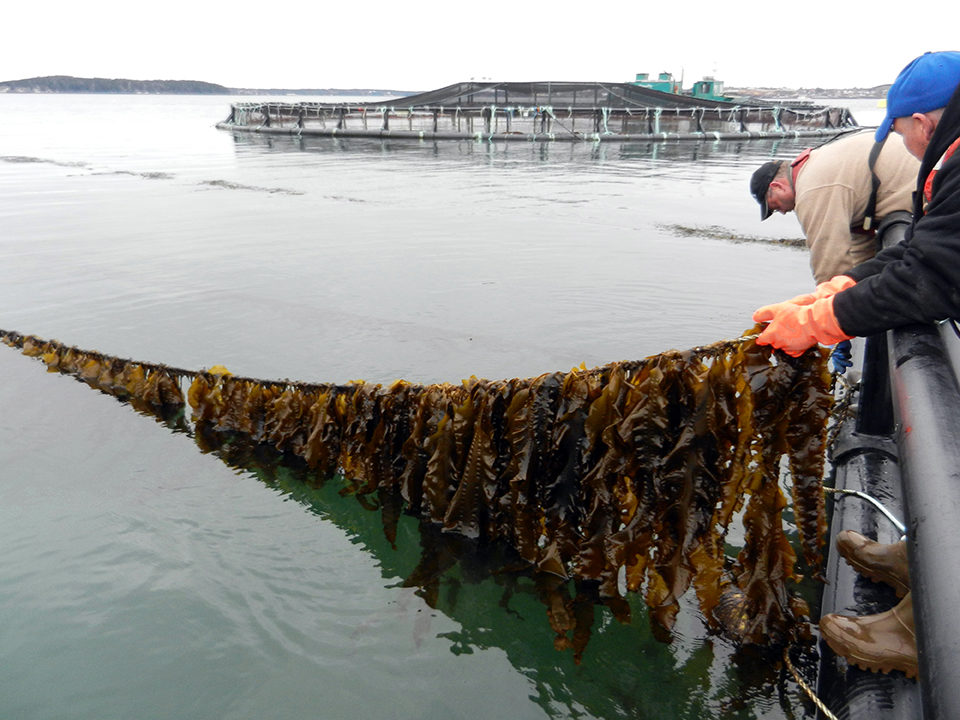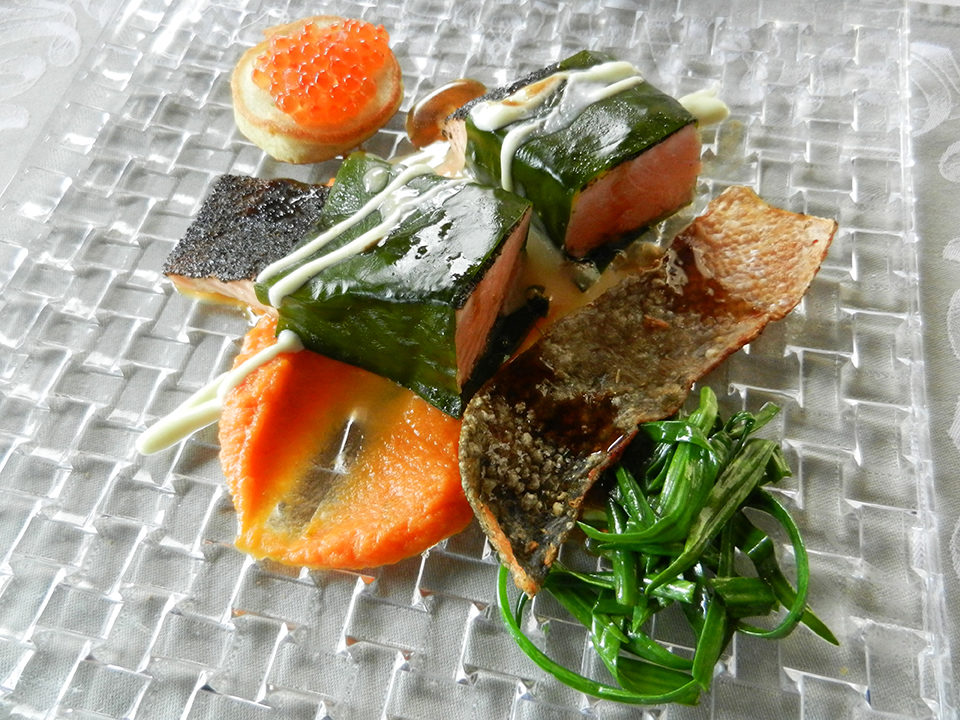It is time for the Turquoise Revolution

It seems aquaculture conferences do not typically attract the phycological community, so knowledge on seaweeds, their functions in ecosystems and their numerous uses in our everyday lives remains minimal, especially in the West. However, seaweed aquaculture is very significant. Seaweeds constitute the largest group of organisms cultured at sea since 2004. In 2012, seaweed represented 49.1 percent of the world mariculture production (Table 1).
Chopin, Evolution of the world mariculture, Table 1
| Species Group | Production (%) 1996 | Production (%) 2000 | Production (%) 2004 | Production (%) 2008 | Production (%) 2010 | Production (%) 2012 |
|---|---|---|---|---|---|---|
| Mollusks | 48.0 | 46.2 | 43.0 | 42.7 | 37.2 | 30.7 |
| Seaweeds | 44.0 | 44.0 | 45.9 | 46.2 | 50.9 | 49.1 |
| Finfish | 7.0 | 8.7 | 8.9 | 8.9 | 9.1 | 11.4 |
| Crustaceans | 1.0 | 1.0 | 1.8 | 1.8 | 1.8 | 8.1 |
| Other aquatic animals | – | 0.1 | 0.4 | 0.4 | 1.0 | 0.7 |
In 2012, 95.6 percent of the world seaweed supply came from aquaculture, and only 4.4 percent was harvested from wild beds. Compared to what the Food and Agriculture Organization of the United Nations designates as “food fish” – finfish, crustaceans, mollusks and other aquatic animals for human consumption – seaweeds were the first group of organisms to pass the 50 percent farmed/wild harvest threshold, in 1971.
The global seaweed aquaculture production was 23.8 million metric tons (MMT) in 2012 for a value of $6.4 billion, and it is estimated that production reached 26.1 MMT in 2013. Its average annual growth rate has been 7.7 percent. From an estimated 10,500 species of seaweeds, only six genera provide 98.9 percent of the production and 98.8 percent of the value: Saccharina, Undaria, Porphyra, Gracilaria, Kappaphycus and Sargassum.
How much of this is known in the Western world? Probably not much, because 96.3 percent of seaweed aquaculture is concentrated in six Asian countries: China (with over 54.0 percent of production), Indonesia, the Philippines, Korea, Japan and Malaysia.
Integrated multi-trophic aquaculture
Integrated multi-trophic aquaculture (IMTA) offers an opportunity to reposition the value and roles seaweeds can have in integrated food production systems and in ecosystem health. Seaweeds are the inorganic extractive component of IMTA – they recapture the dissolved nutrients released from the fed component (fish or shrimp, for example).
The extractive sequestration of nutrients by seaweeds provides ecosystem services that need to be recognized and valued appropriately. Much has been said about carbon sequestration and the development of carbon trading taxes. In coastal environments, mechanisms for the recovering of nitrogen and phosphorus should also be highlighted and accounted for in the form of nutrient trading credits (NTCs), a much more positive approach than taxing.
One often-forgotten function of seaweeds is that they are excellent nutrient scrubbers. If the composition of seaweeds can be averaged at around 0.35 percent nitrogen, 0.04 percent phosphorus and 3.00 percent carbon, and nutrient trading credits are valued at $10 to 30/kg, $4/kg and $30/MT for the compounds, respectively, the ecosystem services for nutrient biomitigation provided by the 23.8 MMT of worldwide annual seaweed aquaculture can be valued at between $892.5 million and $2.6 billion – as much as 40 percent of its present commercial value. This significant value is, however, never noted in any budget sheet or business plan. Seaweeds are typically valued only for their biomass trading value.
The above calculations are based on the costs of recovering nitrogen and phosphorus in wastewater treatment facilities and values often cited for carbon tax schemes. It is interesting to note that the value for carbon is per metric ton, whereas those for nitrogen and phosphorus are per kilogram, a factor of 1,000. Nobody seems to have picked up on that when looking at the sequestration of elements other than carbon. Moreover, having organisms able to accumulate phosphorus is becoming increasingly attractive, as this element will soon be in short supply.
The recognition and implementation of NTCs would give a fair price to extractive aquaculture species. They could be used as financial incentive tools to encourage single-species aquaculturists to contemplate IMTA as a viable aquanomic option to their current practices.

Beyond nutrient biomitigation
Seaweeds can be cultivated without the addition of fertilizers and agrochemicals, especially in an IMTA setting, where the fed aquaculture component provides the nutrients. Seaweed cultivation does not require more arable soil and transformation of land for agricultural activities with accompanying loss of some ecosystem services. If appropriately designed, it can be seen as engineering new habitats and harboring thriving communities, and can be used for habitat restoration. Moreover, it does not need irrigation, on a planet where access to water of appropriate quality is becoming more and more an issue.
As photosynthetic organisms, seaweeds are the only aquaculture component with a net production of oxygen. All other fed and organic extractive components are oxygen consumers. Hence, seaweeds contribute to the avoidance of coastal hypoxia.
While performing photosynthesis, seaweeds also absorb carbon dioxide and hence participate in carbon sequestration, even if in a transitory manner. Consequently, they could be a significant player in the evolution of climate change, slowing down global warming, especially if their cultivation is increased and spread throughout the world. By sequestering carbon dioxide and increasing pH in seawater, seaweeds could also play a significant role in reducing ocean acidification.
Integrated Sequential Biorefinery
For too long, the products of fisheries and aquaculture have been processed according to a simple scheme: one species/one process/one product. Seaweeds remain a relatively untapped resource with a huge potential. With careful planning at the time of harvesting and sequential processing, more than one product can be manufactured from seaweeds.
Seaweeds are prime candidates for the integrated sequential biorefinery (ISBR) approach. On one hand, they can yield a wide range of bio-based, high-value compounds: edible food, food and feed ingredients, biopolymers, fine and bulk chemicals, agrichemicals, cosmetics, bioactives, pharmaceuticals, nutraceuticals and botanicals. On the other hand, lower-value commodity bioenergy compounds – biofuels, biogases, bioalcohols and other biomaterials – can also be generated from seaweeds.
Over the last decade, the Canadian Integrated Multi-Trophic Aquaculture Network at the University of New Brunswick has adopted this ISBR diversification strategy with an industrial partner, Cooke Aquaculture Inc., in Atlantic Canada. IMTA kelps recapture some of the inorganic dissolved nutrients from fish farms, and the partners are developing markets for kelp use in human consumption, cosmetics, fish feed and biochar production, along with eco-labeling and organic certification.
Perspectives
The Western world’s animal-biased aquaculture should recognize and take advantage of the environmental, economic and societal benefits provided by seaweeds. If we compare the evolution of food production on land and at sea, in 2012, agriculture production was 7.0 billion MT, split 85/15 percent between plants and animals, while the total aquaculture production was 90.4 MT, split 26/74 percent between seaweeds and animals. The mariculture production was 48.5 MMT, comprised of 49 percent seaweeds and 51 percent animals.
Mariculture could appear more balanced than total aquaculture, although, as mentioned above, 96.3 percent of seaweed aquaculture is concentrated in six Asian countries. Consequently, if aquaculture is to make a major contribution to the efficient and responsible food production systems of the future, far more production and application of inorganic extractive seaweeds and aquatic plants, and organic extractive animals must be developed in a more evenly distributed manner throughout the world.
It is time to make the Blue Revolution greener and apply agronomic principles to the management of aquatic environments and “aquatic fields,” i.e., it is time for the Turquoise Revolution and aquanomy. Humans will soon not be able to think of mostly land-based agricultural solutions for securing their food and many derived products. They will have to turn increasingly to aquanomy, as we enter a new era of ecosystem responsible aquaculture.
(Editor’s Note: This article was originally published in the September/October 2014 print edition of the Global Aquaculture Advocate.)
Author
-
Dr. Thierry Chopin
Canadian Integrated Multi-Trophic Aquaculture Network
University of New Brunswick
100 Tucker Park Street
Saint John, New Brunswick, E2L 4L5, Canada[97,99,46,106,115,98,110,117,64,110,105,112,111,104,99,116]
Tagged With
Related Posts

Intelligence
Adding flavor complexity to farmed barramundi
Organoleptic attributes such as flavor and aroma are among the most important factors that influence consumer acceptability and demand for fish products. Consumers have identified farmed fish as less complex and lacking “sealike” or “sea-fresh” flavors and aromas.

Intelligence
Brazilian aquaculture: Constraints and challenges (Part 1)
The Brazilian aquaculture industry has been growing steadily during the last two decades. Despite facing a number of challenges it is looking at continued growth and a larger role in the export markets.

Intelligence
Brazilian aquaculture: Constraints and challenges (Part 2)
Brazil will have to deal with an adverse economic and political environment in the next few years. One should expect high value fish products like shrimp, tilapia, Chilean salmon and cod being replaced by more affordable seafood and alternative meats, as consumers keep losing purchasing power due to inflation, unemployment and monetary devaluation.

Intelligence
Aquaculture 2016: Examining the industry’s role in the food system
A wide range of important topics was discussed at the Aquaculture 2016 conference and trade show in Las Vegas last week. Editor Emeritus Darryl Jory shares his notes from the four-day event, which occurs every three years.


